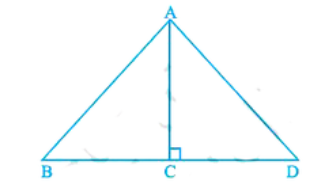If the median drawn on the base of a triangle is half its base, the triangle will be:
right-angled
acute-angled
obtuse-angled
equilateral
The correct Answer is:A
To solve the problem, we need to analyze the relationship between the median, the base of the triangle, and the properties of the triangle itself. Here’s a step-by-step solution:
Step 1: Understand the Median
The median of a triangle is a line segment that connects a vertex to the midpoint of the opposite side. In this case, we are considering a triangle ABC with base BC and median AD drawn from vertex A to the midpoint D of side BC.
Hint: Remember that the median divides the opposite side into two equal segments.
Step 2: Set Up the Given Information
According to the problem, the median AD is half of the base BC. This means we can express this relationship mathematically:
AD=12BC
Hint: Use variables to represent the lengths of the sides for clarity.
Step 3: Analyze the Triangle
Since D is the midpoint of BC, we can denote:
BD=DC=12BC
Now, we have:
- AD=12BC
- BD=DC=12BC
Hint: Visualize the triangle and the median to understand how the segments relate to each other.
Step 4: Apply the Properties of Triangles
In triangle ABD, we have:
- AB=AD (since AD is the median)
- BD=DC
This means triangle ABD is isosceles because two sides (AB and AD) are equal.
Hint: Recall the properties of isosceles triangles, particularly that the angles opposite the equal sides are also equal.
Step 5: Establish Angles
Let the angles at A be denoted as:
- ∠ABD=θ
- ∠DAB=θ
Since triangle ABD is isosceles, we have:
∠ABD=∠DAB
Hint: Use the properties of angles in triangles to find relationships.
Step 6: Analyze Triangle ADC
Similarly, in triangle ADC:
- AD=DC
- Therefore, triangle ADC is also isosceles.
Let:
- ∠ACD=α
- ∠DAC=α
Thus:
∠ACD=∠DAC
Hint: Look for symmetry in the triangle to identify equal angles.
Step 7: Sum of Angles in Triangle ABC
The sum of angles in triangle ABC is:
∠BAC+∠ABC+∠ACB=180∘
Substituting the angles we have:
α+θ+α+θ=180∘
2α+2θ=180∘
α+θ=90∘
Hint: Remember that the angles in a triangle always sum up to 180 degrees.
Step 8: Conclusion
Since ∠BAC=90∘, triangle ABC is a right triangle.
Thus, the triangle will be a right-angled triangle.
Final Answer: The triangle will be a right-angled triangle.
The median of a triangle is a line segment that connects a vertex to the midpoint of the opposite side. In this case, we are considering a triangle ABC with base BC and median AD drawn from vertex A to the midpoint D of side BC.
According to the problem, the median AD is half of the base BC. This means we can express this relationship mathematically:
AD=12BC
Since D is the midpoint of BC, we can denote:
BD=DC=12BC
- AD=12BC
- BD=DC=12BC
In triangle ABD, we have:
- AB=AD (since AD is the median)
- BD=DC
Let the angles at A be denoted as:
- ∠ABD=θ
- ∠DAB=θ
∠ABD=∠DAB
Similarly, in triangle ADC:
- AD=DC
- Therefore, triangle ADC is also isosceles.
- ∠ACD=α
- ∠DAC=α
∠ACD=∠DAC
The sum of angles in triangle ABC is:
∠BAC+∠ABC+∠ACB=180∘
α+θ+α+θ=180∘
2α+2θ=180∘
α+θ=90∘
Since ∠BAC=90∘, triangle ABC is a right triangle.
Similar Questions
Knowledge Check
- Question 1 - Select One
Base of a right angled triangle is
A√(Hypotenous)2+(Perpendicular)2B√(Hypotenous)2−(Perpendicular)2C√(Perpendicular)2−(Hypotenous)2DNone of These
Prove that a line drawn from the vertex of a triangle to its base is bisected by the line joining the mid points of the remaining two sides of the triangle.
View SolutionIn Fig. 9.29 ratio of the area of triangle ABC to the area of triangle ACD is the same as the ratio of base BC of triangle ABC to the base CD of triangle ACD.
 View Solution
View SolutionThe height of a triangle is 2 cm less than twice its base. If the base of the triangle is 6 cm, then what is the area of the triangle?
View SolutionProve that the angle between internal bisector of one base angle and the external bisector of the other base angle of a triangle is equal to one half of the vertical angle.
View SolutionProve that the angle between internal bisector of one base angle and the external bisector of the other base angle of a triangle is equal to one-half of the vertical angle.
View SolutionArea of a triangle = (base×height).
View SolutionProve using vectors: The median to the base of an isosceles triangle is perpendicular to the base.
View Solution

